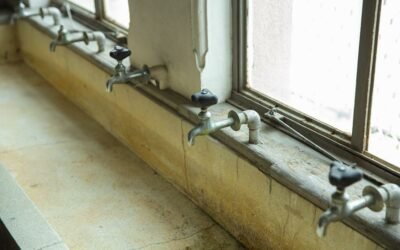Did you know that dish soap can be an effective tool for killing mold? Discover the science behind how dish soap works to eliminate mold and the factors you should consider when using it.
In this article, we will provide you with a step-by-step guide on how to use dish soap to get rid of mold. Additionally, we will explore alternative methods you can use alongside dish soap and important precautions to ensure your safety while eradicating mold.
Key Takeaways
- Dish soap contains surfactants that disrupt the cell membranes of mold.
- The concentration of dish soap affects its effectiveness in killing mold.
- Dish soap may not completely remove mold stains or prevent future mold growth.
- It is important to follow safety precautions when using dish soap as a mold killer.
Understanding the Effectiveness of Dish Soap on Mold
You need to understand how effective dish soap is in killing mold. Dish soap contains surfactants, which are molecules that have hydrophilic (water-loving) and hydrophobic (water-repelling) properties. These surfactants disrupt the cell membranes of mold, causing them to break apart and die. The hydrophilic end of the surfactant molecule attaches to the water molecules, while the hydrophobic end attaches to the mold spores. This dual-action mechanism allows the dish soap to effectively penetrate the mold and eliminate it at its source.
However, it's important to note that dish soap alone may not be sufficient for severe mold infestations or hidden mold colonies. In such cases, professional remediation may be necessary. Additionally, the concentration of surfactants in different dish soaps may vary, so it's crucial to choose a dish soap with a higher concentration of surfactants for better mold-killing efficacy.
To effectively use dish soap for mold removal, dilute it in water according to the manufacturer's instructions. Apply the solution to the affected area using a sponge or spray bottle and scrub thoroughly. Rinse the area with clean water and dry it completely to prevent mold regrowth.
Factors to Consider When Using Dish Soap as a Mold Killer
Consider these factors when using dish soap as a mold killer:
- Concentration: The effectiveness of dish soap in killing mold depends on its concentration. Higher concentrations of dish soap are more likely to effectively eliminate mold spores. Look for dish soaps with a higher percentage of active ingredients.
- Type of Mold: Different types of mold may require different approaches for eradication. While dish soap can be effective against common household molds, such as mildew, it may not be as effective against more stubborn and resilient molds like black mold. In such cases, it's advisable to consult a professional mold remediation service.
- Surface Compatibility: Dish soap is generally safe to use on a variety of surfaces. However, it's essential to consider the compatibility of the dish soap with the surface you're treating. Some surfaces, such as delicate fabrics or certain types of wood, may be sensitive to the chemicals present in dish soap. Always test a small, inconspicuous area before applying dish soap to larger areas.
- Safety Precautions: When using dish soap as a mold killer, it's important to follow safety precautions. Ensure proper ventilation in the area being treated, wear protective gloves and goggles, and avoid inhaling the fumes. Keep children and pets away from the treated area until it's completely dry.
- Effectiveness of Mold Removal: While dish soap can be effective in killing mold, it may not completely remove the mold stains or prevent future mold growth. After using dish soap as a mold killer, it's advisable to thoroughly clean and dry the area to prevent mold from recurring.
Step-By-Step Guide on Using Dish Soap to Eliminate Mold
To effectively eliminate mold using dish soap, follow these step-by-step instructions.
- Gather the necessary materials: a bucket, warm water, dish soap, a scrub brush, and a clean cloth.
- Begin by filling the bucket with warm water, ensuring it isn't too hot to handle.
- Add a generous amount of dish soap to the water, creating a soapy solution. The soap should contain surfactants that will help break down the mold's structure.
- Dip the scrub brush into the soapy water and scrub the moldy area vigorously. Use circular motions to ensure thorough coverage. Pay particular attention to any visible mold growth or discoloration.
- After scrubbing, rinse the area with clean water to remove any soap residue.
- Use a clean cloth to dry the area completely. Remember, moisture promotes mold growth, so it's crucial to dry the affected area thoroughly.
- Dispose of the cloth properly to prevent the spread of mold spores.
- Repeat the process if necessary, ensuring all visible mold is removed.
This step-by-step guide will help you effectively eliminate mold using dish soap.
Alternative Methods to Consider Alongside Dish Soap for Mold Removal
While dish soap can be effective in eliminating mold, it's important to consider alternative methods as well. Mold removal requires a comprehensive approach to ensure complete eradication and prevent future growth. Here are some alternative methods that can be used alongside dish soap:
- Bleach: A powerful disinfectant, bleach can effectively kill mold on hard surfaces. Mix one cup of bleach with one gallon of water and use a spray bottle to apply the solution.
- Vinegar: Known for its antimicrobial properties, vinegar can be used to kill mold on non-porous surfaces. Simply spray undiluted vinegar on the affected area and let it sit for an hour before wiping away.
- Hydrogen Peroxide: Hydrogen peroxide is an effective mold killer and can be used on both porous and non-porous surfaces. Apply a 3% concentration directly onto the mold and let it sit for ten minutes before scrubbing.
- Tea Tree Oil: With its strong antifungal properties, tea tree oil can be used to kill mold and prevent its recurrence. Mix one teaspoon of tea tree oil with one cup of water and spray it onto the mold-infested area.
- Baking Soda: Baking soda acts as a natural deodorizer and can effectively kill mold. Mix one tablespoon of baking soda with one cup of water and spray it onto the mold. Scrub the area to remove the mold and rinse with water.
Precautions and Safety Measures When Using Dish Soap for Mold Eradication
When using dish soap to eradicate mold, it's important to take certain precautions and follow safety measures to ensure effective results. Mold can pose serious health risks, so it's crucial to handle the situation carefully.
Firstly, make sure to wear protective gear such as gloves, goggles, and a mask to prevent any contact with mold spores and potential respiratory issues. Open windows or use fans for proper ventilation during the cleaning process.
Before applying the dish soap solution, remove any visible mold growth by scrubbing the affected area with a brush or sponge. Then, mix a small amount of dish soap with water in a spray bottle or bucket. It's recommended to use a mild dish soap without any harmful chemicals.
Test the solution on a small, inconspicuous area to ensure that it doesn't cause any damage or discoloration. Apply the solution to the mold-infested area and let it sit for a few minutes. Use a brush or sponge to scrub away the mold, making sure to remove all traces of it.
Rinse the area thoroughly with water and dry it completely to prevent any residual moisture that could contribute to further mold growth. Lastly, dispose of any contaminated materials properly and clean all tools used in the process.
Conclusion
In conclusion, dish soap can be an effective tool for eliminating mold. However, it's important to consider factors such as the type of mold, surface material, and concentration of dish soap used.
Following a step-by-step guide and considering alternative methods can enhance the effectiveness of dish soap in mold removal.
It's essential to take proper precautions and safety measures when using dish soap to ensure successful mold eradication.






0 Comments